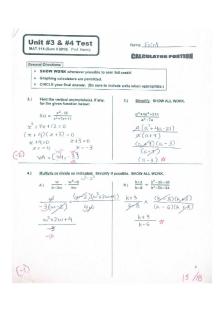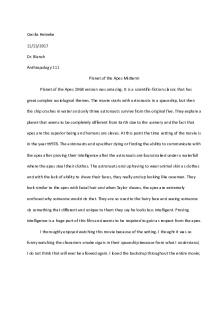APES Unit 3 Test The Living World PDF

| Title | APES Unit 3 Test The Living World |
|---|---|
| Author | Jasmin Rayner |
| Course | Intro To Environmental Science |
| Institution | Saint Louis University |
| Pages | 6 |
| File Size | 263.5 KB |
| File Type | |
| Total Downloads | 28 |
| Total Views | 169 |
Summary
APES unit...
Description
Unit 3: The Living World FRQ’s ★ 2012 #4: ID 2 characteristics of wetlands, wetland food web, ID 2 economic benefits of wetlands, ID human activity that degrades wetlands, compare wetlands and wastelands ★ 2013 #4: ID 2 characteristics of ecosystems w/ high biodiversity, ID 2 activities that result in loss of biodiversity, strategies to reduce biodiversity loss, natural causes of biodiversity loss, ID 2 ecological benefits of greater biodiversity ★ 2014 #4: biogeochemical cycles; C cycle, ocean and lands sinks of C, iD 2 activities that increase C in atmosphere, ED environmental problem of elevated atmospheric C, P cycle ★ 2018 #3: Food webs, migrations, climate change effects on arctic environment Objectives ★ Describe how energy flows through ecosystems ○ Energy flows through ecosystems by consumption ■ From one trophic level to the next, only about 10% of the energy from the previous organism is transferred ○ Producer vs consumer ■ Producer: generate food for themselves ■ Consumers: eat producers or other consumers ○ Heterotroph vs autotroph ■ Hetero: gets food from other animals/plants (carbon) ■ Autro: producer ○ Photosynthesis vs cellular respiration ■ Photosynthesis: converting sunlight into energy ● 6CO2 + 6H2O → C6H12O6+ 6O2 ■ Cellular respiration: converting oxygen and glucose into energy ● C6H12O6 + 6O2 → 6CO2 + 6H2O ★ Describe how energy moves through trophic levels, food chains and food webs ○ Energy moves through by eating other organisms ○ Trophic levels ■ Primary producers: photosynthesis (1st consumer level) ■ Primary consumers: eat producers (2nd consumer level) ■ Secondary Consumers: eat primaries (3rd trophic level) ■ Tertiary consumers: eat secondary (4th consumer level) ■ Quaternary consumers: eat tertiary (5th consumer level) ○ In a food web the arrow shows flow of energy ○ Every organism can have multiple consumer identities ★ Compare GPP and NPP (land and water)
○ GPP: total amount of energy produced by photosynthesis; productivity + respiration ○ NPP: building/increasing the mass of the plant (biomass) ○ Greatest amounts of productivity are found in places where there is a lot of sunlight, water, plants ○ 10% rule: increase in levels leads to a 10% decrease in biomass (ie only 10% of energy is transferred to the consumer) ■ Lower number of predators since there is not as much energy available ■ Better to be vegetarian b/c you have more access to energy ■ 1% of energy from sun is used by PP ○ Virtual lab ■ Light and dark bottle ● Two bottles of water from a fish tank w/ algae (same amount) ● One bottle was covered w/ dark paper and a cup, while the other one was left alone ● Dark bottle: cellular respiration is the only thing measured ● Light bottle: cellular respiration + photosynthesis being measured ● IV: amount of light; DV: DO in water ○ Complete productivity calculations ■ L = light; I = initial; D = dark (for the virtual lab) ■ NPP = GPP - R or L - I/time (literally plug into the equation) ■ R= GPP - NPP; I -D/time ■ GPP = NPP + R; L - D/time ○ Complete calculations based on 10% rule ★ Describe how carbon, nitrogen, and phosphorus cycle w/in ecosystems (know forms and be able to interpret pictures; pg. 119 in binder) ○ Carbon cycle
■
■ Reservoirs: CO2 in atmosphere; peat; old growth forests; cellular respiration of plants; burning fossil fuels ● Able to dissolve in water by phytoplankton ■ Steps ● CO2 in atmosphere is absorbed by plants through photosynthesis ● Those plants are eaten or decomposed ● Carbon is released back into the atmosphere ■ Necessary: helps us breathe ■ Human impact: burning fossil fuels, ○ Nitrogen cycle
■ ■ Reservoir: atmosphere (but we can’t use it, only bacteria can) ■ Necessary: can’t make protein or DNA w/ out ■ Steps ● Fixation ● Nitrification ● Assimilation ● Animals die ● Decomposition ● Denitrification ● Repeats ■ Human impacts ● Adding fertilizers: overwhelm system and bacteria >> leeching ○ Phosphorus cycle
■ ■ ■ ■ ■
Reservoirs: found in rocks (never in atmosphere) Necessary: makes proteins and helps form bones Human impact: adding fertilizer Steps ● Weathering of rocks ● Absorbed plants ● Animals eat plants ● Animals decompose ■ Phosphorus is also found in guano: Birds eat fish and then poop ★ Discuss the values of ecosystems and how humans depend on them ○ Describe various ecosystem services ■ Provisioning: providing things for free ● Food, raw materials, genetic resources, pure water, medicines, energy, materials for crafts ■ Regulating: maintaining homeostasis ● Carbon sequestration, climate regulation, flood regulation, predator regulation, waste decomposition, water purification ■ Cultural: non material value; beauty ● Nature as the subject of books/arts/poems, nature for religious rituals (eagle feathers), recreation, education, therapy/aesthetic ■ Supporting: basic things that make everything else possible ● Nutrient cycle, primary productivity, soil formation, habitat provision, pollination ★ Explain the concept of biodiversity and how it is measured ○ Biodiversity: diversity of species; allows for resilience of the ecosystem ○ Ecosystem diversity vs species diversity vs genetic diversity ■ Ecosystem: variations w/in ecosystem ■ Species: evenness and richness of a species ■ Genetic: number of genetic characteristics
★ ★
★ ★
★
○ Species richness vs species evenness ■ Rich: number of species ■ Evenness: species are equally distributed in population ● High biodiversity w/ both ○ Biodiversity is measured by richness and evenness; Shannon index (don’t need to know) Diverse biomes: rainforests, coral reefs, wetlands, estuaries ○ Biodiversity goes hand in hand w/ productivity Describe the ways in which evolution can occur: any kind of change in the gene pool over time (ie alleles increase or decrease in frequency) ○ Micro vs macro ■ Micro: change on a small scale (a gene changing in a population) ■ Macro: change on a large scale that happens overtime ■ Overtime micro >> macro ○ Variation >> genetic diversity ○ Natural vs artificial selection ■ Natural: natural selective breeding over generations ■ Artificial: humans selecting which genes we like best ○ 5 processes ■ Mutation: new gene is added (affects the gene frequencies) ■ Movement: new immigrants moving in or a group moving out (gene flow) ■ Adaptation: natural selection ■ Non-Random Mating: frequency changes based on appearance ■ Shrink: change can occur ○ Genetic drift: change in frequency of an existing allele ■ Bottleneck: big population shrinks to a tiny population ● Due to hunting, disease, natural disaster >> genetic drift >> low genetic diversity (ie cheetahs) Evolution >> increase in species >> increase in biodiversity Describe major terrestrial biomes (look at binder pages 143-145) ○ Tundra ○ Boreal forest ○ Temperate rainforest ○ Temperate seasonal forest ○ Woodland/shrubland ○ Temperate grassland/cold desert ○ Tropical rainforest ○ Tropical seasonal forest/savanna ○ Subtropical desert Describe major aquatic biomes
○ ○ ○ ○ ○ ○ ○ ○
Streams and rivers Lakes and ponds Wetlands Salt marshes Mangrove swamps Intertidal zone Coral reef Opean ocean...
Similar Free PDFs

Apes unit 2 - 2e2eee2e
- 2 Pages

UNIT 2 Study Guide - APES
- 2 Pages

Unit 3 test - test answers
- 8 Pages

Unit 3 study guide - unit test 3
- 3 Pages

Astronomy - Unit 3 Test - Unit 3
- 8 Pages

Physics Unit 3 Test
- 4 Pages

Unit 3 - Milestone 3 Test
- 3 Pages

(3) The World Wide Web
- 2 Pages

Planet of The Apes Midterm
- 4 Pages

UNIT 9 Healthy Living Workbook
- 46 Pages
Popular Institutions
- Tinajero National High School - Annex
- Politeknik Caltex Riau
- Yokohama City University
- SGT University
- University of Al-Qadisiyah
- Divine Word College of Vigan
- Techniek College Rotterdam
- Universidade de Santiago
- Universiti Teknologi MARA Cawangan Johor Kampus Pasir Gudang
- Poltekkes Kemenkes Yogyakarta
- Baguio City National High School
- Colegio san marcos
- preparatoria uno
- Centro de Bachillerato Tecnológico Industrial y de Servicios No. 107
- Dalian Maritime University
- Quang Trung Secondary School
- Colegio Tecnológico en Informática
- Corporación Regional de Educación Superior
- Grupo CEDVA
- Dar Al Uloom University
- Centro de Estudios Preuniversitarios de la Universidad Nacional de Ingeniería
- 上智大学
- Aakash International School, Nuna Majara
- San Felipe Neri Catholic School
- Kang Chiao International School - New Taipei City
- Misamis Occidental National High School
- Institución Educativa Escuela Normal Juan Ladrilleros
- Kolehiyo ng Pantukan
- Batanes State College
- Instituto Continental
- Sekolah Menengah Kejuruan Kesehatan Kaltara (Tarakan)
- Colegio de La Inmaculada Concepcion - Cebu





